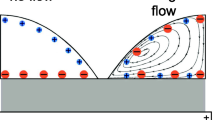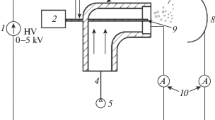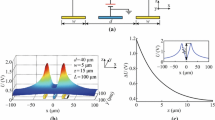Abstract
A numerical investigation of the mechanism by which viral particles suspended in physiologically relevant (i.e., high ionic strength) media can be electrokinetically sampled on a surface is presented. Specifically, sampling of virus from a droplet is taking place by means of a high frequency non-uniform electric field, generated by energized planar quadrupolar microelectrodes deposited on an oxidized silicon chip. The numerical simulations are based on experimental conditions applied in our previous work with vesicular stomatitis virus. A 3D computer model is used to yield the spatial profiles of electric field intensity, temperature, and fluid velocity inside the droplet, as well as the force balance on the virus. The results suggest that rapid virus sampling can be achieved by the synergistic action of dielectrophoresis and electrothermal fluid flow. Specifically, electrothermal fluid flow can be used to transport the virus from the bulk of a sample to the surface, where dielectrophoretic forces, which become significant only at very small length scales away from the surface, can cause its stable capture.











Similar content being viewed by others
References
Arnold WM, Zimmermann U (1988) Electro-rotation: development of a technique for dielectric measurements on individual cells and particles. J Electrostatics 21:151–191
Bhatt KH, Grego S, Velev OD (2005) An AC electrokinetic technique for collection and concentration of particles and cells on patterned electrodes. Langmuir 21:6603–6612
Bird RB, Stewart WE, Lightfoot EN (2002) Transport phenomena, 2nd edn. Wiley, New York
Bradish CJ, Kirkham JB (1968) Morphology of vesicular stomatitis virus (Indiana C) derived from chick embryos or cultures of BHK21/13 cells. J Gen Microbiol 44:359–371
Brake JM, Daschner MK, Luk Y-Y, Abbott NL (2003) Biomolecular interactions at phospholipid-decorated surfaces of thermotropic liquid crystals. Science 302:2094–2097
Castellanos A, Ramos A, González A, Green NG, Morgan H (2003) Electrohydrodynamics and dielectrophoresis in microsystems: scaling laws. J Phys D Appl Phys 36:2584–2597
Docoslis A, Tercero-Espinoza LA, Israel BA, Alexandridis P, Abbott NL (2004) Dielectrophoretic capture of viral particles from media of physiological ionic strength. AIChE Conf Proc 134a
Docoslis A, Tercero Espinoza LA, Zhang B, Cheng L, Israel BA, Alexandridis P, Abbott NL (2006) Using non-uniform electric fields to accelerate the transport of viruses to surfaces from media of physiological ionic strength. Langmuir (in press)
Dürr M, Kentsch J, Müller T, Schnelle T, Stelzle M (2003) Microdevices for manipulation and accumulation of micro- and nanoparticles by dielectrophoresis. Electrophoresis 24:722–731
Gagnon Z, Chang H-C (2005) Aligning fast alternating current electroosmotic flow fields and characteristic frequencies with dielectrophoretic traps to achieve rapid bacteria detection. Electrophoresis 26:3725–3737
Green NG, Morgan H, Milner JJ (1997) Manipulation and trapping of sub-micron bioparticles using dielectrophoresis. J Biochem Biophys Methods 35:89–102
Green NG, Ramos A, Morgan H (2000) AC electrokinetics: a survey of sub-micrometre particle dynamics. J Phys D Appl Phys 33:632–641
Green NG, Ramos A, González A, Morgan H, Castellanos A (2002) Fluid flow induced by nonuniform ac electric fields in electrolytes on microelectrodes. III. Observation of streamlines and numerical simulation. Phys Rev E 66:026305
Grom F, Kentsch J, Müller T, Schnelle T, Stelzle M (2006) Accumulation and trapping of hepatitis A virus particles by electrohydrodynamic flow and dielectrophoresis. Electrophoresis 27:1386–1393
Hayden O, Bindeus R, Haderspock C, Mann K-J, Wirl B, Dickert FL (2003) Mass-sensitive detection of cells, viruses and enzymes with artificial receptors. Sens Actuators B Chem 91:316–319
Heida T, Rutten WLC, Marani E (2002) Understanding dielectrophoretic trapping of neuronal cells: modelling electric field, electrode–liquid interface and fluid flow. J Phys D Appl Phys 35:1592–1602
Hoettges KF, Hughes MP, Cotton A, Hopkins NAE, McDonnell MB (2003) Optimizing particle collection for enhanced surface-based biosensors. IEEE Eng Med Biol Mag 22(6):68–74
Huang L-F, Yang H-H, Su C-C, Wu T-Z, Chen L-K (2001) Application of simultaneous immunosensor for early detection of Dengue virus.Chem Sens 17(Suppl B):478–480
Hughes MP (2003) Nanoelectromechanics in engineering and biology. CRC Press, Boca Raton
Hughes MP, Morgan H, Rixon FJ, Burt JPH, Pethig R (1998) Manipulation of herpes simplex virus type 1 by dielectrophoresis. Biochim Biophys Acta 1425:119–126
Hughes MP, Morgan H, Rixon FJ (2001) Dielectrophoretic manipulation and characterization of herpes simplx virus-1 capsids. Eur Biophys J 30:268–272
Jones TB (1995) Electromechanics of particles. Cambridge University Press, New York
Kaatze U (1989) Complex permittivity of water as a function of frequency and temperature. J Chem Eng Data 34:371–374
Lide DR (2001) Handbook of chemistry and physics, 81st edn. CRC Press, London
Morgan H, Green NG (2003) AC electrokinetics: colloids and nanoparticles. Research Studies Press Ltd., Baldock
Müller T, Gerardino A, Schnelle T, Shirley SG, Bordoni F, De Gasperis G, Leoni R, Fuhr G, (1996) Trapping of micrometre and sub-micrometre particles by high-frequency electric fields and hydrodynamic forces. J Phys D Appl Phys 29:340–349
Nakai T, Howatson AF (1966) The fine structure of vesicular stomatitis virus. Virology 35:268–281
O’Brien RW (1986) The high-frequency dielectric dispersion of a colloid. J Colloid Interface Sci 113:81–93
Perry RH, Green DW, Maloney JO (1997) Perry’s Chemical Engineers’ Handbook, 7th edn. McGraw-Hill, New York
Pohl HA (1978) Dielectrophoresis. Cambridge University Press, Cambridge
Radke SM, Alocilja EC (2005) A microfabricated biosensor for detecting foodborne bioterrorism agents. IEEE Sens J 4:744–750
Ramos A, Morgan H, Green NG, Castellanos A (1998) AC electrokinetics: a review of forces in microelectrode structures. J Phys D Appl Phys 31:2338–2353
Sigurdson M, Wang D, Meinhart CD (2005) Electrothermal stirring for heterogeneous immunoassays. Lab Chip 5:1366–1373
Turcu I, Lucaciu CM (1989) Dielectrophoresis: a spherical shell model. J Phys A 22:985–993
Wang D, Sigurdson M, Meinhart CD (2005) Experimental analysis of particle and fluid motion in AC electrokinetics. Exp Fluids 38:1–10
Wong PK, Chen C-Y, Wang T-H, Ho C-M (2004) Electrokinetic bioprocessor for concentrating cells and molecules. Anal Chem 76:6908–6914
Wu J, Ben Y, Battigelli D, Chang H-C (2005) Long-range AC electroosmotic trapping and detection of bioparticles. Ind Eng Chem Res 44:2815–2822
Acknowledgements
The authors would like to acknowledge financial support by NSERC (RGPIN 261691-03) and infrastructure funding by CFI/OIT and Queen’s Advisory Research Council. JAW would like to acknowledge the support of NSERC in the form of a PGS D scholarship. MRT would like to acknowledge Queen’s University for support in the form of a MacLaughlin scholarship. The fabrication of the microelectrodes was performed at the Cornell Nanofabrication Facility (a member of the National Nanofabrication Users Network), Cornell University, Ithaca, NY, USA.
Author information
Authors and Affiliations
Corresponding author
Appendix
Appendix
1.1 Physical parameters
-
The equation for medium density, ρM, as a function of temperature T(K) was obtained from data given by Perry et al. (1997):
$$\rho_{\rm M} = [- 3.9854 \times 10^{{- 6}}(T - 273.15)^{2} - 3.7765 \times 10^{{- 5}} (T - 273.15) + 1.0001]\rho_{0}$$The constant ρ0 was taken equal to 1,000 kg/m3.
-
Medium conductivity, σM, was obtained from data regression to experimental measurements on saline water of similar ionic strength (Lide 2001) over the temperature range of interest (T in K):
$$\sigma_{\rm M} = 0.52 + 0.0171(T - 273.15)$$ -
An expression for the relative permittivity of the medium was obtained from data given by Kaatze (1989):
$$\varepsilon_{\rm M} = 87.297 - 0.3156(T - 273.15)$$ -
The viscosity variation of water with temperature T (K) is described by the following equation (Perry et al. 1997):
$$\eta_{M} = (- 0.0077426(T - 273.15)^{3} + 1.0344(T - 273.15)^{2} - 57.283(T - 273.15) + 1790.8) \times 10^{{- 6}} (\hbox{kg m}^{-1} \hbox{s}^{-1})$$ -
Expressions for the parameters α and β were obtained from the derivatives of ɛM and σM (previously shown) with respect to temperature.
$$\alpha = \frac{{^{1}}}{{\sigma_{\rm M}}}\left(\frac{{\partial \sigma_{\rm M}}}{{\partial T}}\right) = \frac{{0.0171}}{{0.471 + 0.0171(T - 273.15)}}$$$$\beta = \frac{{^{1}}}{{\varepsilon_{\rm M}}}\left(\frac{{\partial \varepsilon_{\rm M}}}{{\partial T}}\right) = - \frac{{0.3156}}{{87.297 - 0.3156(T - 273.15)}}$$
1.2 Boundary conditions
The following boundary conditions were applied for the solution of the numerical problem:
-
Potential difference across opposite electrodes: ΔV rms = 2.8 V
-
External boundaries (medium–air and silicon dioxide–air interfaces):
-
Zero surface charge: − n·D = 0; (D: electric charge displacement)
-
Isothermal: T = T o = 293°C
-
Slip symmetry: \({n \cdot \vec{u}\, =\,0}\) (medium–air interface)
-
-
Medium–substrate interface:
-
No-slip condition: \({\vec{u}\, =\,0}\)
-
-
Vertical boundaries (symmetry planes in one quarter of the drop):
-
Surface charge: − n·D = 0 (symmetry)
-
Heat flux: − n·q = 0 (symmetry); \({q\, =\, - k\vec{\nabla}T\, +\,\rho_{\rm M}\,C_{p}\,T \cdot \vec{u}}\)
-
Slip symmetry: \({n \cdot \vec{u}\, =\,0}\)
-
Rights and permissions
About this article
Cite this article
Wood, J.A., Zhang, B., Tomkins, M.R. et al. Numerical investigation of AC electrokinetic virus trapping inside high ionic strength media. Microfluid Nanofluid 3, 547–560 (2007). https://doi.org/10.1007/s10404-006-0145-0
Received:
Accepted:
Published:
Issue Date:
DOI: https://doi.org/10.1007/s10404-006-0145-0




